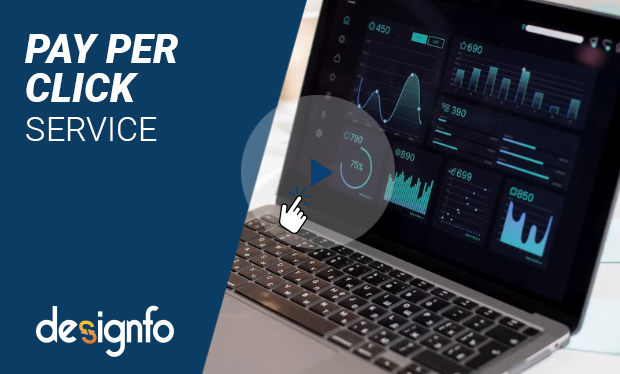Pay Per Click (PPC) marketing is an advertising model where advertisers pay each time a user clicks on one of their ads. This type of marketing is usually done through platforms such as Google AdWords. It can effectively reach potential customers who are actively searching for related products or services. With PPC marketing, businesses can create highly targeted campaigns, track and measure results, and adjust their strategies for optimal results. Designfo’s team of experts will work with you to create a comprehensive PPC strategy that aligns with your business goals, audience targeting, and budget. Whether you’re looking to drive more traffic to your website, increase brand awareness, or generate more sales.
- help@designfo.net
- +91 9831037463



Pay Per Click (PPC) Marketing
Get started with our Pay Per Click (PPC) Marketing services by contacting us online or calling +91 983 103 7463
Optimize Your Brand's Success Through Cost-Per-Click Marketing
PPC advertising is a powerful way for businesses to reach their target audience, but making the right decisions is crucial for success.
What is PPC advertising:
PPC advertising is online advertising that allows businesses to pay for each click on their ads. This type of advertising will enable you to reach your target audience quickly and effectively, making it an ideal option for many businesses.
The benefits of PPC advertising:
Cost-effective: You only pay when someone clicks on your ad.
Targeted: You can reach the right people at the right time with the right message.
Measurable: You can track and measure your results, making it easy to optimize your campaigns.
Immediate: PPC advertising can provide quick results and drive traffic to your website.
Choosing the right PPC platform: There are many different PPC platforms, including Google Ads, Bing Ads, and Facebook Ads. Each venue offers additional features, targeting options, and benefits, so it’s important to choose the right one for your business.
Creating effective PPC campaigns:
Define your target audience: Who are you trying to reach?
Choose the right keywords: What words or phrases will people use to find your business?
Write compelling ad copy: What message do you want to convey?
Set a budget: How much are you willing to spend on PPC advertising?
Measure your results: Analyze your campaigns to see what’s working.
Conclusion: PPC advertising can be a valuable tool for businesses, but it’s essential to make the right decisions to succeed. With the right platform, effective campaigns, and careful measurement, your business can reach new heights through PPC advertising.
Choosing the Ideal Strategy for Your Brand: SEO or Cost-Per-Click Advertising?
SEO and PPC are two popular digital marketing strategies. While SEO focuses on improving website ranking through organic search results, PPC involves paid advertising. The right strategy for your brand depends on your goals, budget, and target audience. Designfo offers both SEO and PPC services, and our experts can help you determine the best approach for your business. You can achieve higher visibility, drive traffic, and increase conversions with a well-planned and executed strategy. Let us help you make the right decision for your brand with our SEO and PPC expertise.
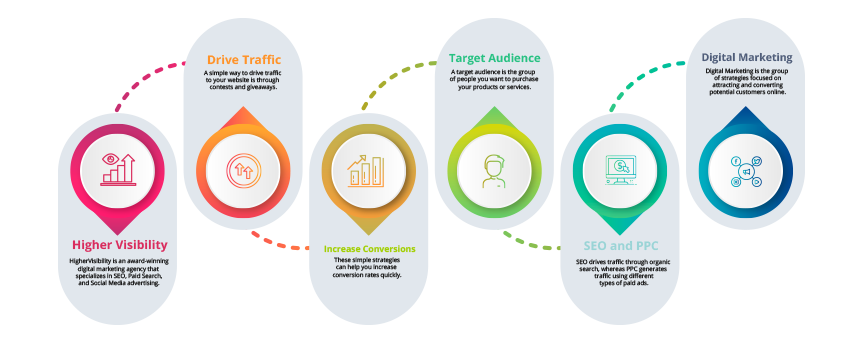
SEO and PPC are digital marketing strategies that drive website traffic and increase online visibility. SEO focuses on optimizing a website and its content to rank organically in search engine results. On the other hand, PPC involves paying for advertising space on search engines or websites to drive traffic to a website. Both have their unique benefits and drawbacks.
SEO is cost-effective in the long term as it doesn’t require ongoing payments like PPC. However, it can take time to see results as it involves making changes to the website and its content to improve its ranking. On the other hand, PPC is a faster way to drive traffic to a website as it involves paying for advertising space. However, it requires a budget for ongoing payments and can become costly over time.
In terms of targeting, SEO is broader as it focuses on ranking higher for relevant keywords, whereas PPC allows for a more specific audience and geographic location targeting. It’s also important to note that PPC offers more control over the message and appearance of ads.
Ultimately, the right strategy for a brand depends on its goals, budget, and target audience. A combination of both SEO and PPC can provide the best results, as they complement each other and can help drive traffic to a website from different sources.
Maximize Consumer Search Opportunities Through Cost-Per-Click Advertising
PPC (Pay-Per-Click) marketing is a valuable tool for businesses looking to take advantage of consumer search opportunities. This form of advertising allows companies to bid on specific keywords or phrases and display their ads to a highly targeted audience. Unlike traditional advertising methods, PPC allows you to target specific audiences and track the results of your advertising campaigns in real time. With PPC, you can reach your target audience at the right place, at the right time, and with the right message.
One of the critical benefits of PPC marketing is the ability to target specific audiences. With advanced targeting options, you can reach consumers actively searching for products or services like yours. This targeted approach allows you to maximize your ad spend and reach potential customers who are most likely to convert into paying customers.
Another benefit of PPC marketing is the ability to measure the success of your campaigns. With real-time tracking and reporting, you can see how your campaigns perform and make adjustments to improve their results. This information can help you make informed decisions about your advertising budget and overall marketing strategy.
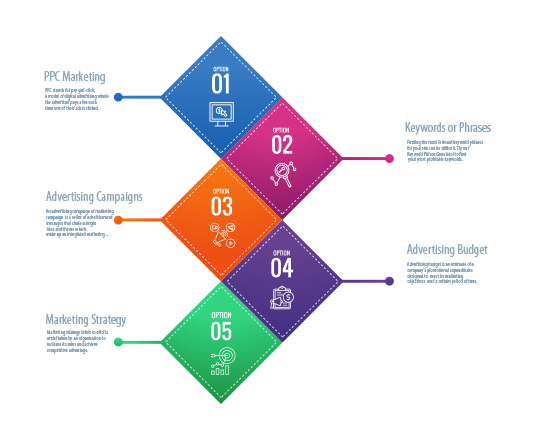
PPC advertising also allows for flexibility in budget and ad placement. You can set a specific budget for each campaign and choose where your ads will be displayed. This allows you to control your costs and maximize the impact of your advertising dollars.
Overall, PPC marketing is a powerful tool to help you reach new customers and drive sales. The ability to target specific audiences, measure success, and control costs is a valuable addition to any marketing strategy. By leveraging PPC marketing, you can take advantage of consumer search opportunities and grow your business.
What is Cost-Per-Click Marketing and How Does It Function?
Maximizing Your ROI with Pay Per Click Services
Pay-per-click (PPC) is a type of online advertising that allows businesses to reach potential customers through targeted advertising campaigns. In a PPC campaign, firms bid on keywords related to their products or services and place ads on search engines or websites that their target audience is likely to visit. The advertiser is charged a fee when a user clicks on the ad. This fee is paid per click because the advertiser only pays when someone clicks on their ad.
PPC campaigns can be an effective way to reach new customers and drive traffic to a website. With the proper targeting and ad copy, PPC campaigns can help businesses increase brand awareness, generate leads, and drive sales. PPC advertising provides businesses with immediate results and allows them to adjust their campaigns in real-time to achieve their desired outcomes.
However, PPC marketing requires careful planning and ongoing monitoring to ensure that campaigns are effective and achieve the desired results. It’s also essential to have a well-designed landing page that converts visitors into customers. Our team of experts can help you develop and execute a successful PPC campaign that leverages the power of consumer search opportunities and delivers results for your brand.
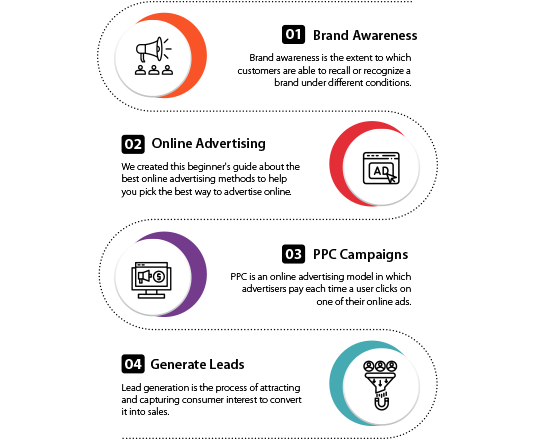
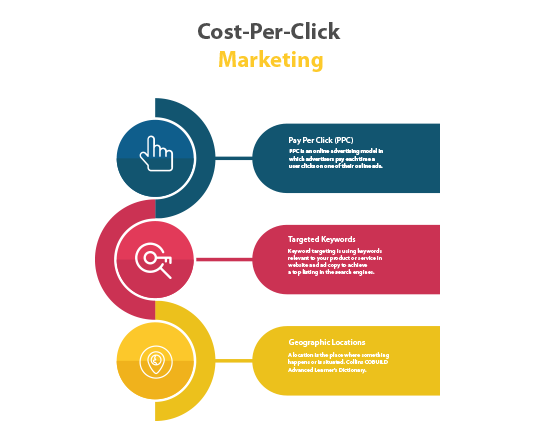
What is Cost-Per-Click Marketing?
Pay Per Click (PPC) is an advertising model used in digital marketing. The concept behind PPC is that advertisers pay each time a user clicks on one of their online ads. The cost per click can vary depending on several factors, including the ad type, the targeted keywords, and the competition for those keywords.
PPC advertising can be a powerful tool for businesses looking to reach potential customers in a highly targeted and cost-effective way. Advertisers can set their budgets, target specific keywords and geographic locations, and even track the performance of their campaigns in real time. This makes it possible to fine-tune their approach and maximize the return on their investment.
One of the benefits of PPC advertising is that it can be highly targeted. Advertisers can select the keywords they want to target, the geographic locations they want to reach, and even the time of day they want their ads to appear. This allows them to get a highly targeted audience with a relevant and timely message.
Another benefit of PPC advertising is that it is fast. Unlike traditional advertising methods, which can take weeks or even months to produce results, PPC advertising can generate leads and conversions within hours of launching a campaign. This makes it a valuable tool for businesses that need to create quick outcomes.
Overall, PPC advertising is a powerful and flexible way to reach potential customers and drive sales for your business. If you’re looking for a cost-effective and highly targeted advertising solution, then PPC is worth considering.
Can You Elaborate on the Various Forms of PPC Advertisements?
Pay-per-click (PPC) advertising is a highly effective way to reach consumers actively searching for your business’s products or services. PPC advertisements are shown at the top or bottom of search engine results pages and appear when consumers search for specific keywords related to your business. Several PPC ads are designed to meet the needs of different companies and campaigns.
PPC advertising operates on a bidding system, where advertisers choose relevant keywords and place bids for ad placement.
These ads are typically displayed in prime positions, ensuring that your business gets visibility when users are most likely to take action.
You only pay when a user clicks on your ad, making it a cost-effective solution for businesses looking to maximize their return on investment.
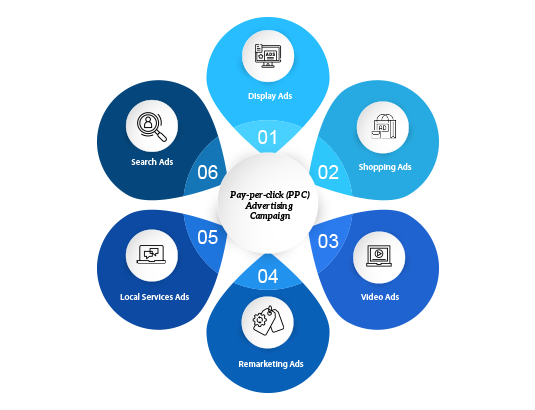
Search Ads
Search ads are the most common type of PPC ad. They appear at the top of search engine results pages when consumers search for specific keywords related to your business.
Display Ads
Display ads are eye-catching graphic ads on websites across the internet. They can be targeted to specific audiences based on factors like age, location, and interests.
Shopping Ads
Shopping ads showcase your products and encourage people to buy. They appear at the top of search engine results pages and include product images, prices, and information.
Video Ads
Video ads are short, eye-catching videos that appear before, during, or after online videos. They can target specific audiences based on demographics, interests, and behaviours.
Remarketing Ads
Remarketing ads are shown to people who have already interacted with your business in some way. For example, if someone visits your website but doesn’t make a purchase, you can show them an ad later to remind them of your products.
Local Services Ads
Local Services Ads are a type of advertising that helps businesses reach potential customers who are looking for services in their local area. These ads are displayed on search engines such as Google and allow customers to easily find a business based on their location, services offered, and ratings. The benefit of Local Services Ads is that they are targeted to people who are actively searching for the specific services offered by the business.
Each type of PPC ad has its benefits and drawbacks, so it’s essential to consider your business goals, target audience, and budget when deciding which ad is right for you. The experts of Designfo can help you make the right choice and create a highly effective PPC advertising campaign that drives results for your business.
Can You Explain the Functioning of PPC Marketing?
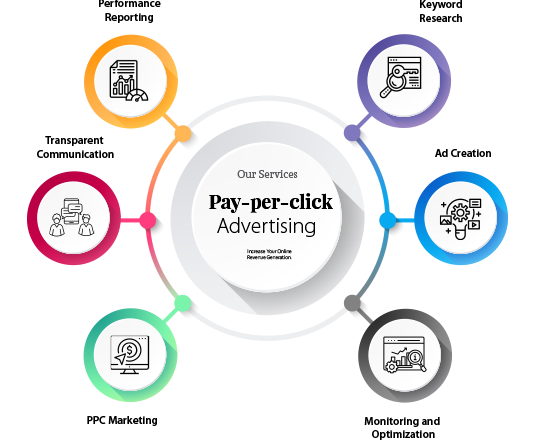
PPC or Pay-per-click advertising is an online advertising model in which advertisers pay a fee each time one of their ads is clicked. It’s a way of buying visits to your website instead of attempting to “earn” those visits organically. PPC advertising is an effective and efficient way to drive traffic to your website and generate leads.
Here’s how PPC advertising works:
Keyword research: Research the keywords and phrases relevant to your business. The goal is to identify the keywords that people are searching for and determine which ones are the most profitable for you to target.
Ad creation: Create an ad that includes a headline, description, and URL. Depending on the platform, your ad can also have images or videos.
Bid on keywords: Bid on the keywords you want to target. You will pay each time someone clicks on your ad. The amount you pay depends on the competition for that keyword and other factors, such as the relevance of your ad and the quality of your landing page.
Ad launch: Once you have created your ad and selected your keywords, you can launch your campaign. Your ad will start appearing in search results or on websites participating in the PPC network.
Monitoring and optimization: It is essential to regularly monitor your campaign to see what’s working and what’s not. You can use the data from your campaign to optimize your ads and make changes to improve your results.
In conclusion, PPC advertising is a powerful tool for businesses of all sizes. By bidding on keywords and displaying ads in front of people searching for your offer, you can quickly and effectively drive traffic to your website and generate leads. Designfo is a leading provider of PPC marketing services, and our team of experts can help you create and manage an effective PPC campaign that delivers results.
Our Services Aim to Enhance Your Quality Score and Increase Your Online Revenue Generation.
Designfo helps businesses improve their online revenue through better Quality Scores for their PPC campaigns. Quality Score is a metric used by search engines to determine the relevance and value of your ads and landing pages. A high-Quality Score means lower cost per click and higher ad placement, leading to increased traffic and conversions.
Our team of experts will work with you to analyze and optimize your campaigns, ensuring that your ads and landing pages are relevant and user-friendly. We’ll also continuously monitor your Quality Scores and make adjustments as needed to maintain and improve them. With our help, you can expect a significant increase in your online revenue and a better return on investment for your PPC advertising spend.
In addition, our comprehensive approach to PPC marketing includes regular performance reporting, transparent communication, and expert advice on how to get the most out of your campaigns. Whether you’re starting with PPC or have been using it for years, our team is here to help you achieve your business goals.
What Makes PPC Marketing an Effective Strategy for Your Business?
Achieving Measurable Results with Pay Per Click Services
Pay Per Click (PPC) marketing is a powerful tool for businesses to reach their target audience and increase online revenue. PPC advertising allows companies to place their advertisements in front of consumers actively searching for products or services similar to those offered by the business. This type of advertising is highly targeted, allowing companies to reach their ideal customer base with minimum waste.
PPC advertising is flexible and can be adjusted in real-time, allowing businesses to change their campaigns to achieve the desired results. Additionally, PPC advertising provides measurable results, allowing enterprises to track their return on investment and make informed decisions about their marketing strategies.
Moreover, PPC advertising can be cost-effective, as businesses only pay when a consumer clicks on their advertisement. This can help enterprises to manage their advertising budget and avoid overspending on ineffective marketing tactics.
In conclusion, Pay Per Click marketing is a valuable investment for businesses looking to increase their online revenue, reach their target audience, and achieve measurable results from their marketing efforts.
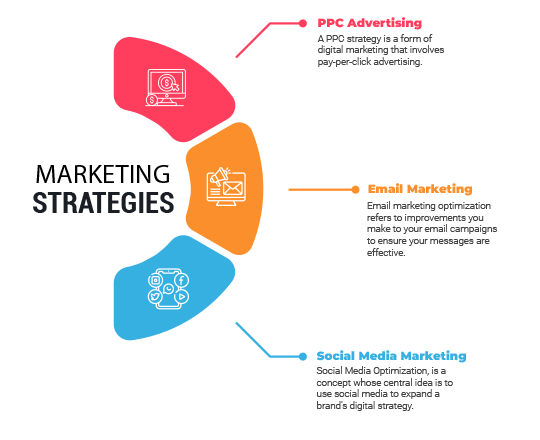

Low Barrier to Entry
Low Barrier to Entry refers to the minimal effort, cost, or investment required to start a business or enter a market. This makes it easier for new players to join the call, increasing competition and offering more choices for consumers. A low Barrier to Entry often leads to innovation and lower prices, but it can also result in market saturation and reduced profitability for established players. To remain competitive, companies must constantly adapt and innovate, offering their customers unique and high-quality products or services.

Fast Results
Fast results are a crucial advantage of implementing a Pay Per Click (PPC) marketing strategy. With PPC, you can quickly reach a targeted audience and generate leads and sales within days or even hours of launching a campaign. This starkly contrasts with other forms of digital marketing, such as Search Engine Optimization (SEO), which can take weeks or even months to see significant results. PPC offers a quick and efficient way to drive traffic and boost revenue, making it an ideal choice for businesses that need to achieve their goals and succeed in the online marketplace quickly.

Quick Experimentation
Quick experimentation is a crucial benefit of Pay Per Click (PPC) marketing. PPC allows businesses to test and refine their advertising strategies quickly and efficiently. With a low barrier to entry and fast results, PPC makes it easy for companies to try out new ideas, keywords, and ad copy and quickly measure their success. Businesses can identify what works best for them and make data-driven decisions, ultimately driving more leads and conversions. The ability to experiment rapidly and iterate on advertising strategies makes PPC a highly effective tool for businesses looking to grow and succeed online.

Expansive Traction Channels
PPC advertising provides businesses with expansive traction channels that can reach a large, targeted audience in a short amount of time. With the ability to target specific demographics, locations, and interests, PPC campaigns can quickly drive traffic to a website and generate leads and conversions. Tracking and analytics tools allow for quick experimentation and optimization, giving businesses the flexibility to make changes and improve results in real-time. Whether through search engines, social media, or display networks, PPC offers businesses a cost-effective way to quickly reach and engage their target audience and grow their online presence.

Trackable Data
Trackable data is one of the significant benefits of Pay Per Click (PPC) advertising. With PPC, you can easily measure and track the performance of your campaigns, allowing you to make informed decisions about future campaigns. You can see exactly how many clicks your ads are generating, your conversion rates, and your return on investment (ROI). This allows you to tweak and optimize your campaigns to get the best results while providing valuable insights into what is working and what is not. This data enables you to make informed decisions about your marketing strategy and get the most out of your investment in PPC advertising.

Improved Brand Visibility
Improved brand visibility is one of the critical benefits of a well-executed Pay Per Click (PPC) marketing strategy. PPC advertising allows businesses to reach a wider audience and target specific demographics, creating more significant brand awareness and recognition. This can lead to increased website traffic, conversions and revenue. By closely monitoring and analyzing the data from PPC campaigns, businesses can make informed decisions about their marketing strategies and make necessary adjustments to improve brand visibility and reach even more potential customers.

Granular Targeting
Granular targeting in PPC advertising allows you to precisely target your ideal audience by narrowing down demographics, behaviours, and interests. By using good targeting options such as location, device type, and keyword match type, you can create laser-focused campaigns that attract the right customers to your website. The result is increased conversion rates, a better return on investment, and a higher return on ad spend. Whether a small business or a multinational corporation, granular targeting enables you to effectively reach and engage with your target audience.

One-time Campaign Promotions
One-time campaign promotions are a powerful way to drive short-term sales and traffic to your website. This strategy allows you to target specific audiences and offer limited-time deals and discounts to incentivize customers to purchase. By using Pay-Per-Click (PPC) advertising, you can precisely target and reach the right audience with your promotion, leading to a higher return on investment. Utilizing PPC with a well-planned one-time campaign can be a cost-effective way to drive sales and improve brand awareness.

Immediate and Consistent Traffic
PPC advertising offers immediate and consistent traffic to your website by displaying ads to users searching for keywords related to your products or services. This provides a steady stream of leads and can help improve your website’s visibility and overall online presence. Additionally, PPC ads allow you to target specific audiences, ensuring that the right people see your message. With PPC, you can achieve consistent traffic and maximize your marketing budget.

Total Customization
Total Customization refers to the ability to tailor your advertising efforts to your business’s specific needs and goals. This level of customization in PPC advertising gives businesses complete control over their campaigns’ targeting, messaging, and overall approach. The ability to precisely target your audience and tailor your messaging to their needs and interests can ensure your ads are more effective, driving more conversions and increasing ROI. By utilizing Total Customization in PPC advertising, businesses can better align their marketing efforts with their overall business strategy, resulting in a more cohesive and successful approach to digital advertising.
Can You Provide an Explanation of Search Engine Marketing?
Accelerate Your Growth with Pay Per Click Advertising
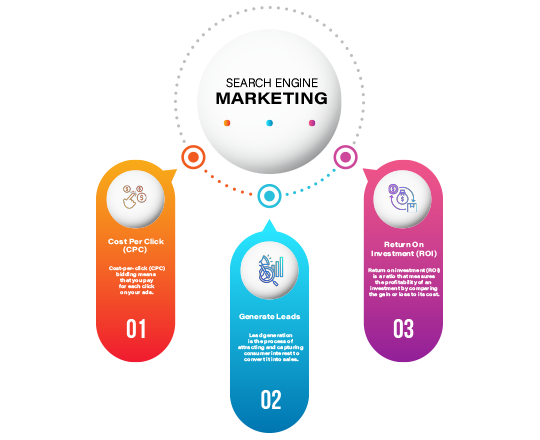
Search Engine Marketing (SEM) is a type of digital marketing that involves the promotion of websites by increasing their visibility in search engine results pages (SERPs) through paid advertising. SEM aims to drive more traffic to a website by showing ads to users searching for specific keywords related to a business’s products or services.
In SEM, businesses bid on keywords for which they want their ads to appear in search results. The cost per click (CPC) is determined by the competition for each keyword and the ad’s relevance to the keyword and search query. The higher the bearing, the lower the CPC, which leads to a higher return on investment (ROI) for the advertiser.
SEM is a way to quickly drive traffic to a website, generate leads, and measure the success of campaigns with trackable data such as click-through and conversion rates. It allows businesses to reach a specific audience and reach them at the moment they are searching for the products or services being offered.
One of the main advantages of SEM is that it offers highly targeted and flexible advertising, allowing businesses to target specific demographics, locations, and devices. Additionally, SEM can provide immediate results, allowing enterprises to adjust their campaigns to optimize their ROI quickly.
Overall, SEM is an effective way to reach a specific audience and drive more traffic to a website, leading to increased leads and sales. It offers businesses the ability to reach their target audience when they are searching for the products or services offered and provides measurable results to help track and optimize their campaigns.
Can You Elaborate on the Workings of SEM?
SEM, or Search Engine Marketing, is a form of online advertising that involves the promotion of websites by increasing their visibility in search engine results pages (SERPs). This is accomplished through paid advertising on search engines like Google and Bing.
The primary goal of SEM is to drive more traffic to a website by appearing in the sponsored results of a search engine. To do this, advertisers create ads and bid on relevant keywords to their target audience. These keywords are then used to trigger the display of the advertisement when someone searches for them on the search engine.
When an advertiser bids on a keyword, they set a maximum cost-per-click (CPC) that they are willing to pay each time their ad is clicked. The cost of each click is determined by the advertiser’s bid and the competition for the keyword. The more advertisers bid on a particular keyword, the higher the cost-per-click.
SEM advertising campaigns are managed through an advertising platform, such as Google Ads. The advertiser sets up their campaign, selects the keywords they want to target, and creates ads appearing in the search results. The ads can include text, images, and even video.
To measure the effectiveness of an SEM campaign, advertisers track various metrics, such as click-through rate (CTR), conversion rate, and cost-per-conversion. CTR is the number of clicks divided by the number of times the ad was shown. Conversion rate is the percentage of clicks that result in a desired action, such as a sale or a sign-up. Cost-per-conversion is the amount spent on the campaign divided by the number of conversions.
SEM is an effective way to reach a large, targeted audience quickly and efficiently. By bidding on keywords relevant to their target audience, advertisers can ensure that their ads will be seen by people actively searching for the products or services they offer. Additionally, tracking a campaign’s success in real-time allows advertisers to make data-driven decisions about improving their movements.
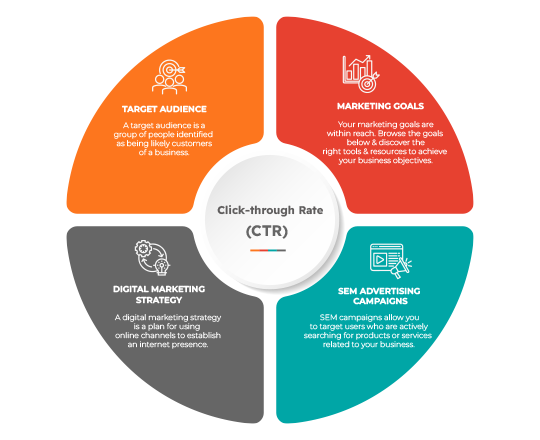
SEM is also a flexible form of advertising. Advertisers can start or stop a campaign anytime and adjust their bids and ad spending based on the results they see. This allows them to respond quickly to changes in the market and adjust their campaigns accordingly.
In conclusion, SEM is a valuable tool for businesses looking to increase their online visibility and drive more traffic to their website. By bidding on relevant keywords, creating effective ads, and tracking the success of their campaigns, businesses can reach their target audience and achieve their marketing goals.
Can You Explain the Significance of SEM in Digital Marketing?
Search Engine Marketing (SEM) is an essential component of digital marketing as it helps businesses reach their target audience and achieve their marketing goals. Here are a few reasons why SEM is necessary for digital marketing:
1. Targeted reach: SEM allows businesses to target specific audience segments based on keywords, demographics, and location. This means that companies can reach the right people with their message and increase the likelihood of conversions.
2. Increased visibility: SEM increases website visibility in search engine results through paid advertising. This leads to increased website traffic and higher brand exposure. By appearing at the top of search engine results pages (SERPs), businesses can stand out from their competitors and capture the attention of potential customers.
3. Measurable results: SEM provides real-time data and metrics, such as click-through rate (CTR), conversion rate, and cost-per-conversion. This allows businesses to track the success of their campaigns and make data-driven decisions about how to improve them. By measuring key metrics, companies can optimize their campaigns for maximum ROI.
4. Flexibility: SEM is a flexible form of advertising. Advertisers can start or stop a campaign anytime and adjust their bids and ad spending based on the results they see. This allows them to respond quickly to changes in the market and adjust their campaigns accordingly.
5. Cost-effective: SEM can be cost-effective compared to other advertising forms, as businesses only pay when someone clicks on their ad. Companies can control their ad spending and avoid wasted spending on ineffective ads.
In conclusion, SEM is an essential component of digital marketing as it allows businesses to reach their target audience, increase their visibility, track the success of their campaigns, and be flexible and cost-effective in their advertising efforts. By incorporating SEM into their digital marketing strategy, businesses can achieve their marketing goals and grow their business.
An Agency Specializing in PPC That Achieves Positive Outcomes
Making the Most of Pay Per Click Services for Your Business
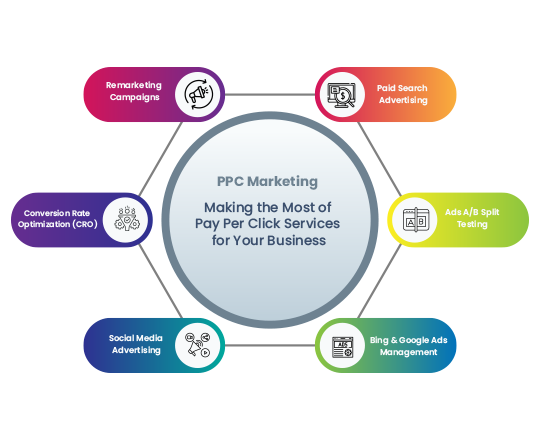
Designfo is a PPC agency that delivers positive results for its clients. Our team of experts has extensive experience in the field and uses cutting-edge technology and strategies to drive traffic and conversions for your business. We understand the importance of having a well-rounded approach to PPC campaigns and tailoring our processes to meet each client’s needs.
Our services include keyword research, ad creation, bid management, and landing page optimization. We continually monitor and analyze your campaigns to ensure they deliver the desired results and adjust as needed. We also provide transparent reporting, so you can see the results of our efforts and understand how we’re driving growth for your business.
We understand that your success is our success. That’s why we work tirelessly to deliver positive results for our clients. Our focus on results-driven campaigns has helped us build a reputation as a top PPC agency. Contact us today to learn how we can help grow your business with effective PPC campaigns.
Services in PPC Marketing
Transform Your Online Presence with PPC Advertising

Keyword Research & Analysis
Our team of experts uses advanced tools and techniques to identify the most effective keywords for your industry and target audience. We consider your business goals, competition, and search volume to ensure your keywords drive the right traffic to your website.
Our Keyword Research & Analysis services are essential to any successful PPC campaign. We continuously monitor and adjust your keywords to ensure they remain relevant and practical. Our focus on delivering positive client results sets us apart as a top PPC agency. Contact us today to learn how our Keyword Research & Analysis services can help your business succeed online.
Paid Search Advertising
Designfo is a leading provider of Paid Search Advertising services. Our team of experts specializes in creating and managing successful campaigns across multiple platforms, including Google Ads and Bing Ads. We use data-driven strategies and cutting-edge technology to deliver targeted, cost-effective advertising solutions that drive results for your business.
Our Paid Search Advertising services include keyword research, ad creation, bid management, and continuous optimization to ensure your campaigns deliver the desired results. Our focus on delivering positive ROI for our clients sets us apart as a top PPC agency. Contact us today to learn how our Paid Search Advertising services can help grow your business.
Bing & Google Ads Management
Our certified professional team has extensive experience managing successful campaigns across both platforms. We use data-driven strategies and advanced technology to create targeted, cost-effective advertising solutions that drive results for your business.
Our Bing & Google Ads Management services include keyword research, ad creation, bid management, and continuous optimization to ensure your campaigns deliver positive results. We provide transparent reporting and regular communication to keep you informed about the performance of your campaigns. Contact us today to learn how our Bing & Google Ads Management services can help grow your business.
Remarketing Campaigns
Our team of experts uses data-driven strategies and advanced technology to deliver personalized, targeted advertising solutions that drive results. Whether you’re looking to increase conversions or boost brand awareness, our Remarketing Campaigns can help.
Our Remarketing Campaigns include ad creation, bid management, and continuous optimization to ensure your campaigns deliver the desired results. We use data to segment your audience and deliver personalized messages that resonate with them, increasing the likelihood of conversion. Contact us today to learn how our Remarketing Campaigns can help grow your business.
Landing Page Conversion Optimization
Designfo offers expert Landing Page Conversion Optimization services to help businesses increase conversions and drive results. Our team of experts uses data-driven strategies and advanced technology to optimize your landing pages for maximum impact. From headline creation to call-to-action placement, our team will work with you to create landing pages that convert visitors into customers.
Our Landing Page Conversion Optimization services include A/B testing, heat mapping, and continuous optimization to ensure your pages deliver the desired results. We use data to identify areas for improvement and make data-driven decisions to drive conversions. Contact us today to learn how our Landing Page Conversion Optimization services can help grow your business.
Ads A/B Split Testing
We offer comprehensive Ads A/B Split Testing services to help businesses optimize their advertising campaigns for maximum impact. Our team of experts uses advanced technology and data-driven strategies to test different aspects of your campaigns, from ad copy to images, to determine the best-performing combination.
Our Ads A/B Split Testing services include designing and implementing tests, analyzing results, and making data-driven recommendations to optimize your campaigns. We continuously monitor your movements and adjust as needed to ensure they deliver the desired results. Contact us today to learn how our Ads A/B Split Testing services can help optimize your advertising campaigns and grow your business.
Social Media Advertising
Designfo is a full-service PPC agency offering expert Social Media Advertising services. Our team of experts specializes in creating and managing successful campaigns across multiple platforms, including Facebook, Instagram, Twitter, and LinkedIn. We use data-driven strategies and cutting-edge technology to deliver targeted, cost-effective advertising solutions that drive results for your business.
Our Social Media Advertising services include ad creation, targeting, bid management, and continuous optimization to ensure your campaigns deliver the desired results. We use data to segment your audience and deliver personalized messages that resonate with them, increasing the likelihood of conversion. Contact us today to learn how our Social Media Advertising services can help grow your business.
Amazon PPC
Designfo is a leading provider of Amazon PPC services, helping businesses increase sales and grow their presence on the world’s largest e-commerce platform. Our team of certified Amazon experts uses data-driven strategies and cutting-edge technology to deliver targeted, cost-effective advertising solutions that drive results.
Our Amazon PPC services include keyword research, ad creation, bid management, and continuous optimization to ensure your campaigns deliver the desired results. We provide transparent reporting and regular communication to keep you informed about the performance of your campaigns. Contact us today to learn how our Amazon PPC services can help grow your business on Amazon.
PPC Management
Our team offers comprehensive PPC Management services for businesses looking to increase their online visibility and drive results. Our team of certified experts uses data-driven strategies and advanced technology to deliver targeted, cost-effective advertising solutions that meet your specific needs and goals.
Our PPC Management services include keyword research, ad creation, bid management, and continuous optimization to ensure your campaigns deliver the desired results. We provide transparent reporting and regular communication to keep you informed about the performance of your campaigns. Contact us today to learn how our PPC Management services can help grow your business.
Conversion Rate Optimization (CRO)
Our team uses data-driven strategies and advanced technology to optimize your website for maximum impact. From improving website load times to creating compelling call-to-actions, our team will work with you to create a website that converts visitors into customers.
Our Conversion Rate Optimization (CRO) services include A/B testing, heat mapping, and continuous optimization to ensure your website delivers the desired results. We use data to identify areas for improvement and make data-driven decisions to drive conversions. Contact us today to learn how our Conversion Rate Optimization (CRO) services can help grow your business.
Nextdoor Advertising
Our Nextdoor Advertising services include ad creation, targeting, bid management, and continuous optimization to ensure your campaigns deliver the desired results. We use data to segment your audience and deliver personalized messages that resonate with them, increasing the likelihood of conversion. Contact us today to learn how our Nextdoor Advertising services can help grow your business.
YouTube Ads
Our YouTube Ads services include ad creation, targeting, bid management, and continuous optimization to ensure your campaigns deliver the desired results. We use data to segment your audience and deliver personalized messages that resonate with them, increasing the likelihood of conversion. Whether you’re looking to drive brand awareness or conversions, Designfo’s YouTube Ads services can help you reach your goals. Contact us today to learn more.
What Sets Designfo's PPC Services Apart from the Competition
Unlocking the Power of PPC Advertising for Your Business
Designfo’s PPC services offer a unique combination of expertise, creativity and data-driven strategies that set us apart from the rest. Our team of certified professionals has extensive experience in developing and executing successful PPC campaigns across various industries. We use advanced tools and technologies to target the right audience and maximize ROI. Our focus on data-driven decision-making and continuous optimization ensure that your campaigns consistently deliver results. With a track record of success and satisfied clients, it’s no wonder Designfo’s PPC services are considered the best in the industry. Trust us to drive your online advertising success.
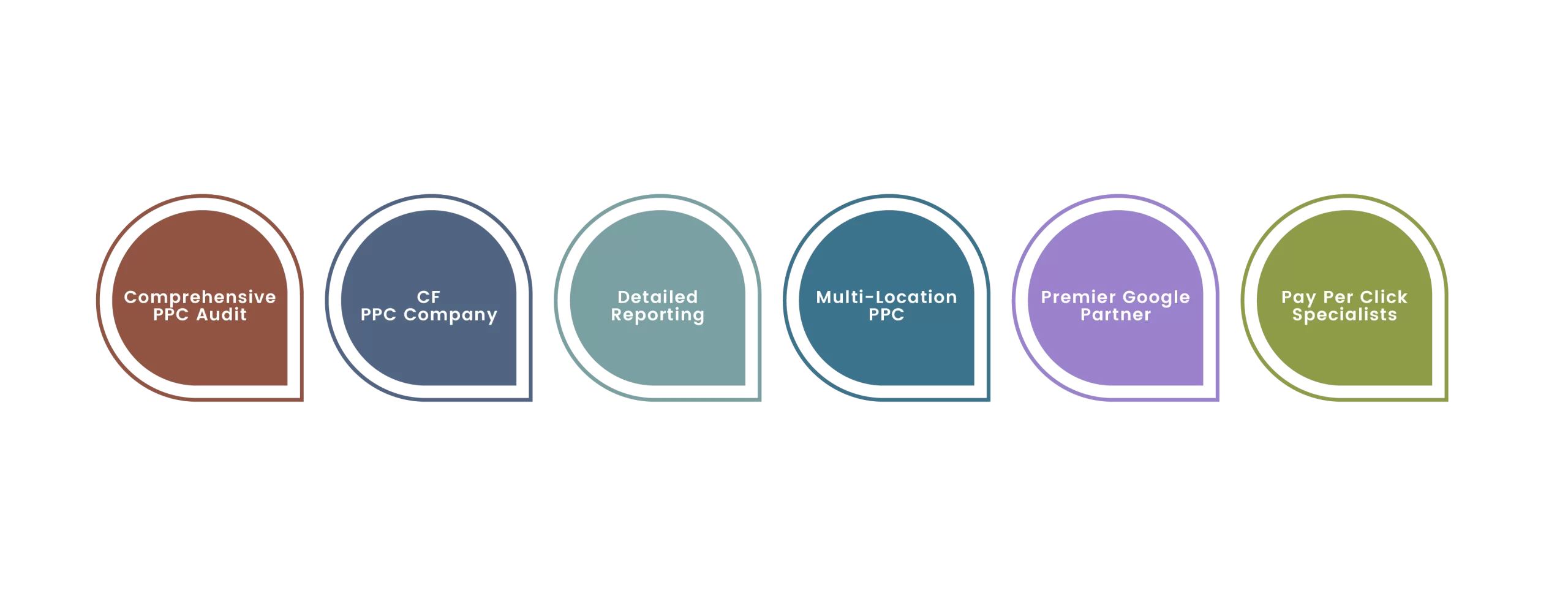
Comprehensive PPC Audit
Designfo’s Comprehensive PPC Audit provides a deep dive into your current PPC campaigns to identify areas of improvement and optimize performance. Our team of experts will thoroughly analyze your account structure, ad copy, keyword targeting, and landing pages to ensure your campaigns are running efficiently. The audit also includes a competitive analysis to help you stay ahead of the curve. The result of the Comprehensive PPC Audit is a detailed report with actionable insights and recommendations for improvement. With our audit, you can rest assured that your campaigns are in good hands and your advertising budget is being spent wisely.
Customer-Focused PPC Company
Our company is a customer-focused PPC company that prioritizes the needs and goals of its clients above all else. Our team of experts works closely with you to understand your business and develop customized PPC campaigns that drive results. From keyword research to landing page optimization, we focus on delivering high-quality, personalized service to ensure your satisfaction. We believe in transparency and open communication, providing regular reports and performance updates so you can stay informed and involved throughout the process. Success is a team effort, and we are committed to working with you every step of the way. Choose Designfo as your customer-focused PPC partner for effective and efficient PPC results.
Detailed Reporting
Designfo’s Detailed Reporting system provides a clear and concise overview of your PPC campaign’s performance, so you can stay informed and make data-driven decisions. Our team of experts use advanced tools and technologies to track and analyze the success of your campaigns, providing regular reports with detailed metrics such as impressions, clicks, conversion rates, and ROI. We also comprehensively analyze your target audience and ad placements, giving you insight into the factors driving your success. With our Detailed Reporting system, you can be confident that your campaigns are delivering the results you need to succeed.
Multi-Location PPC
Our team of experts specializes in creating and executing customized PPC campaigns that effectively target customers in each location. From local keywords to custom landing pages, we focus on delivering localized and relevant content that resonates with your target audience. We also provide detailed reporting for each location, allowing you to track and compare performance across multiple markets. With Designfo’s Multi-Location PPC services, you can reach new customers, increase brand awareness, and drive sales across multiple locations. Choose us for effective and efficient Multi-Location PPC solutions.
Premier Google Partner
As a Premier Google Partner, our team has access to exclusive training, tools and resources from Google, allowing us to stay ahead of the curve and deliver innovative solutions for our clients. Our team of certified professionals has a proven track record of delivering successful PPC campaigns, and our commitment to continuous learning and improvement ensures that we are always up-to-date with the latest best practices.
Dedicated Pay Per Click Specialists
Designfo is a company of dedicated Pay Per Click (PPC) specialists committed to delivering effective and efficient PPC solutions for our clients. Our team of experts has extensive experience in developing and executing successful PPC campaigns across various industries, using data-driven strategies and advanced tools to maximize ROI. We believe in personalizing our approach to meet each client’s unique needs and goals, working closely with you to understand your business and deliver the results you need. Our dedication to continuous learning and improvement ensures that we are always up-to-date with the latest best practices and technologies.
Why Investing in Pay Per Click Advertising is a Smart Choice
Leveraging the Benefits of Pay Per Click Advertising
Pay Per Click (PPC) advertising is an excellent investment for businesses of all sizes. It allows you to quickly, effectively, and precisely reach your target audience. Here are some of the key benefits of investing in PPC advertising:
Measurable and Trackable Results: With PPC advertising, you can track and measure the results of your campaigns in real time. This means you can see which ads are performing well and adjust your strategy accordingly.
Targeted Advertising: PPC advertising allows you to target specific groups of people based on factors such as location, age, interests, and more. This means you can reach your ideal customers with the right message at the right time.
Cost-Effective: PPC advertising allows you to only pay for actual clicks to your website. This means you’re not wasting money advertising to people who aren’t interested in your products or services.
Quick Results: PPC advertising provides immediate results, allowing you to see the impact of your campaigns within days or even hours. This makes it an ideal solution for businesses looking to drive short-term sales or awareness.
Increased Visibility: PPC advertising helps increase your website’s visibility, making it easier for people to find your business online. This increased visibility can also help improve your search engine optimization (SEO) efforts.
Better ROI: PPC advertising can generate a high return on investment (ROI) by driving qualified traffic to your website and converting that traffic into sales or leads.
PPC advertising is a powerful tool for businesses looking to drive results. Our team of dedicated Pay Per Click specialists has the expertise and experience to deliver effective and efficient PPC solutions for our clients. From keyword research to landing page optimization, we focus on providing the results you need to succeed. Our commitment to continuous learning and improvement ensures that we are always up-to-date with the latest best practices and technologies.
In conclusion, investing in PPC advertising is a great way to reach your target audience quickly, effectively, and precisely. With its measurable and trackable results, targeted advertising, cost-effectiveness, quick results, increased visibility, and better ROI, PPC advertising is a wise investment for any business looking to drive growth and success.
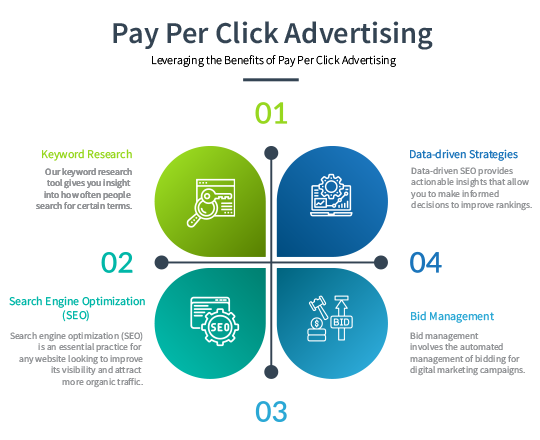
Pay Per Click Services FAQs!
What is Pay Per Click (PPC) advertising, and how does it work?
Pay Per Click (PPC) advertising is a type of online advertising where advertisers pay each time a user clicks on one of their ads. Advertisers bid on keywords related to their products or services, and their ads appear in search engine results or on websites within the advertising network.
What are the benefits of PPC advertising for my business?
PPC advertising is an excellent investment for businesses as it allows for targeted and measurable advertising. It will enable companies to reach their ideal customers when they search for products or services similar to the business offers.
Can you help me target my ideal customer with PPC advertising?
Our team can help you target your ideal customer by researching keywords, demographics, and location targeting. We will create ad campaigns that reach the right people at the right time.
How do you determine the cost of a PPC campaign?
The cost of a PPC campaign is determined by a bidding process on keywords and is influenced by factors such as the competition for the keyword, the ad’s relevance, and the landing page’s relevance.
How will you track and measure the success of my PPC campaigns?
Our team will track and measure the success of your PPC campaigns using metrics such as click-through rate (CTR), conversion rate, and return on ad spend (ROAS). These metrics will help us continually optimize your campaigns for better performance.

Designfo, a full-service digital marketing agency, specializes in helping businesses attract, engage, and convert leads through effective online marketing strategies. Trust Designfo to drive results for your business.
